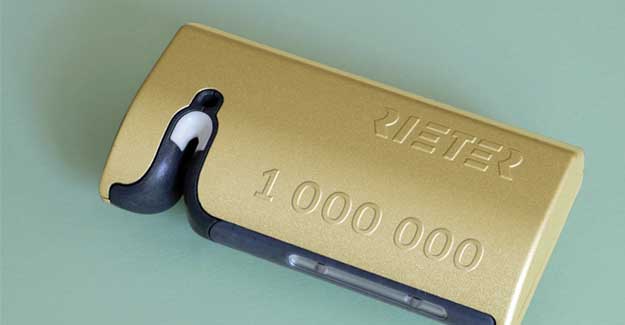
Rieter’s Yarn Clearers Become Popular With Spinning Sector
Rieter displayed its self-developed yarn clearer back in 1999 at ITMA Paris, which is based on the principle of absolute measurement of yarn diameter. Since then, Rieter has installed more than one million yarn clearers on its rotor and air-jet spinning machines.
The technology of textile machinery and the entire spinning process is constantly improving. However, not all yarn faults can be avoided by good preparation and processing of the sliver. Even today, unavoidable yarn faults occur in spinning process. The pressure on quality of the final product is growing, as good quality is the precondition for the competitiveness of the yarn manufacturer.
Earlier, only a few machines were equipped with yarn clearers. Today, rotor and air-jet spinning machines with clearers are the standard. Rieter was the first company to develop its own yarn clearer which is fully integrated into existing machine electronics. This concept has several advantages. A significant one is the joint control panel for the machine and the clearer system. Furthermore, new yarn clearing functions could be integrated which are not feasible with an external system.
Rieter, as the first spinning machinery supplier worldwide, commercially launched a clearer which is based on a new, unique optical principle and measures the absolute yarn diameter. Unlike other optical clearers for spinning machines, the Rieter yarn clearer is unique as it uses an optical smart sensor with a large number of small light-sensitive elements, similar to a modern digital camera.
The sensor was developed by a company of the Swatch Group in Switzerland for Rieter's specific requirements and continues to be manufactured there. The silicon chip combines light-sensitive elements and a microprocessor for continuous analysis of yarn signal.
Rieter's yarn clearer is protected by more than 15 registered patents and is founded on more than 15 years of experience with billions of tonnes of yarn cleared by a million clearers (Figure 1).
The yarn clearer is fully integrated into the spinning machine. Compared to external solutions, far fewer components are required. This makes the system less vulnerable to faults.
The customer has a further advantage of being able to retrieve information on the yarn quality as well as all existing machine information on the same control panel. The short and direct connection to the spinning unit and to the robot allows functions which are not possible with an external stand alone system (Figure 2).
The full integration of Rieter’s yarn clearer into existing machines permits special functions like precise evaluation of the piecer by exact speed profile in the piecing process as well as monitoring of the P 26 polyester system in the air-jet spinning machine.
Modern evaluation algorithms also enable the detection of changed yarn structure, minimal deviations in yarn hairiness and yarn with reduced tenacity.
The yarn clearer based on Rieter's unique optical-digital principle consists of an adapted light source, a lens with a specially designed shape and a customised smart sensor. Standard clearers – optical or capacitive – send analogue signals which is converted into digital form in subsequent step. The Rieter sensor directly supplies precise digital data for the following analysis. This reduces fault sources and increases accuracy of results. The high speed of the smart sensor and the very small light-sensitive elements facilitate a very small, high-resolution measuring zone of 0.2 mm. This means the yarn is measured with extreme precision. The output value is therefore very accurate. With other clearers, the measuring zone is several millimetres long and the output value is only a mean value of several millimetres and is thus relatively imprecise.
The yarn clearer fits in all Rieter rotor and air-jet spinning machines as well as simultaneously fulfils machine-specific requirements. On one hand, uniform operator interfaces as well as monitoring functions for rotor and air-jet spinning are used, while on the other hand, specific functions are provided which meet requirements of different yarn technologies.
Textile Excellence
If you wish to Subscribe to Textile Excellence Print Edition, kindly fill in the below form and we shall get back to you with details.








